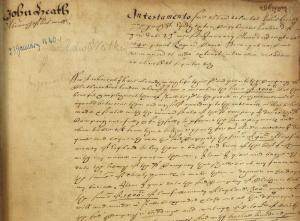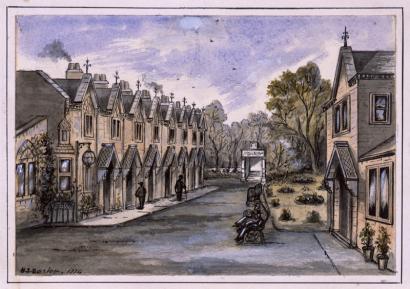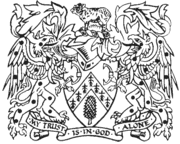In his 1641 will, John Heath, Citizen and Clothworker, bequeathed £1500 to the Company with specific instructions to use £300 of this sum to build five tenements as almshouses. Each tenement was to comprise two rooms. The remaining money was to be used to purchase lands or tenements in fee simple,  with an annual value of sixty pounds.[1] He directed the Master and Wardens of the Company to select ten poor male clothworkers to occupy these tenements or almshouses during the later years of their life. The rental income from the lands would be used by the Company to support these almsmen and to maintain the properties.[2]
with an annual value of sixty pounds.[1] He directed the Master and Wardens of the Company to select ten poor male clothworkers to occupy these tenements or almshouses during the later years of their life. The rental income from the lands would be used by the Company to support these almsmen and to maintain the properties.[2]
On receipt of the money following Heath’s death in 1641, the Company made plans to erect the almshouses on some of their existing grounds at Islington. In June 1648, the Company began to survey the land to assess its suitability for building the almshouses.[3] By July, the Company had decided to proceed with the building and engaged a bricklayer and carpenter to begin work.[4] The work seems to have continued apace, with the Court Orders noting the first payments to the workmen in August.[5] By January 1649, the first almsmen had been selected for the new almshouses.[6] It was later agreed that the properties would be divided by drawing lots.[7] The early years of Heath’s almshouses seem to have been fairly uneventful. The only activity noted for the first six years is the changing of the resident almsmen.
The conduct of the almsmen seems to have been a continual concern for the Company. In August 1655, the Company asked three almsmen to leave the property due to unspecified ‘misdemeanours’.[8] The almsmen petitioned the Court for readmittance to the almshouses in the following October, but the outcome of their request was not recorded in the Court Orders.[9] In September 1656, the Company surveyed the almshouses. The later half of the 1650s was dominated by disputes with almsmen. In October 1657, an almsman, Mr. Heath is noted in the Court Orders as having been chastised by the Company due to his behaviour, with the stern warning ‘to carry himself better from this point on’.[10] On the same day at the Court, Mr. Hughes was asked to avoid his place due to his conduct.[11] By 1660, Mr. Bright was receiving warnings from the Company not to entertain a female companion in his room.[12] In February 1687, the Company also revoked pension payments to two almsmen ‘due to their drunkenness and keeping of bad hours in their return from London to their lodgings’.[13] Their poor behaviour was noted as having been responsible for the death by drowning of a fellow almsman.[14] The well-being of the tenants was also a major concern for the Company. The Company appointed a nurse, for example, to care for two very sick almsmen was recorded in 1683.[15]
The Company undertook their first repairs at the almshouses in January 1656, with the employment of a glazier to mend broken windows noted in the Court Orders. In July 1659, the Company sent appointees to discuss the possibility of bringing river water directly into the almshouses.[16] By August, construction near the almshouses appears to have caused problem, with surveyors appointed to view a ‘sink in the wall of the Company’s almhouses’, which the neighbours had made.[17] The dispute with the almshouses’ neighbours seems to have continued for a number of years. In 1666, Mr. Bonfey, a Company appointee gave a report on his survey at Islington to the Court. He informed the Court that ‘upon view of the dispute it seemed that the almsmen were very annoyed about a house of office and a sink running through the Company's ground there from the house adjoining to the said almshouse wherein one Mr. Hunneywood dwells’.[18] The Company resolved to issue a notice to Mr. Hunneywood requesting the re-routing of the passage of his vault and watercourse from the Company’s ground.[19] By June 1666, the Company had reached an agreement with Hunneywood. He was to pay an annual fee of two shillings to the Court for the continued use of the vault through the almhouses’ lands at Islington.[20]
Orders. In July 1659, the Company sent appointees to discuss the possibility of bringing river water directly into the almshouses.[16] By August, construction near the almshouses appears to have caused problem, with surveyors appointed to view a ‘sink in the wall of the Company’s almhouses’, which the neighbours had made.[17] The dispute with the almshouses’ neighbours seems to have continued for a number of years. In 1666, Mr. Bonfey, a Company appointee gave a report on his survey at Islington to the Court. He informed the Court that ‘upon view of the dispute it seemed that the almsmen were very annoyed about a house of office and a sink running through the Company's ground there from the house adjoining to the said almshouse wherein one Mr. Hunneywood dwells’.[18] The Company resolved to issue a notice to Mr. Hunneywood requesting the re-routing of the passage of his vault and watercourse from the Company’s ground.[19] By June 1666, the Company had reached an agreement with Hunneywood. He was to pay an annual fee of two shillings to the Court for the continued use of the vault through the almhouses’ lands at Islington.[20]
By 1681, the Company had begun to make further improvements at Islington. In October, the Company appointed Mr. Stevenson to consult about the cost of installing a pump and river water at the almshouses.[21] In November 1681, the Company engaged surveyors to view the property of the Company’s tenant at Islington Mr. Lamnott, along with the almshouses to determine what repairs to make.[22] Unspecified repairs were undertaken at the properties following the survey.[23] In January 1682, the Company ordered a stone cutter to view the properties at Islington and to erect the Company’s arms on the buildings.[24] The Clothworkers’ Company maintained the almshouses at Islington until 1825, when they were moved to a site at Monkwell Street.[25] The Company moved the almshouses back to Islington in 1872. They were sold in 1964.[26]
[1] TNA PROB 11/186, Will of John Heath, 23 January 1641..
[2] Ibid
[3] The Clothworkers’ Company Archive (hereafter CCA), Court Orders, CL B/1/8, f. 189v, Survey of lands at Islington, 20 June 1848.
[4] CCA, Court Orders, CL B/1/8, ff 190r-190v, Instructions for almshouses to be built at Islington, 18 July 1648.
[5] CCA, Court Orders, CL B/1/8, f. 194r, Payments to workmen at Islington, 1 September 1648,
[6] CCA, Court Orders, CL B/1/8, f. 200r, Occupants selected for Islington, 30 January 1649.
[7] CCA, Court Orders, CL B/1/8, f. 200v, Grants of property at Islington by drawing lots, 15 March 1649.
[8] CCA, Court Orders, CL B/1/8, ff 65v-66r, Three almsmen asked to avoid, 29 August 1655.
[9] CCA, Court Orders, CL B/1/8, f. 67v, Petition by almsmen to return to almshouse, 1 October 1655.
[10] CCA, Court Orders, CL B/1/9, f. 98v, Heath warned by the Company, 5 October 1657.
[11] CCA, Court Orders, CL B/1/9, f. 98r, Hughes warned to avoid the almshouse, 5 October 1657.
[12] CCA, Court Orders, CL B/1/9, f. 139v, Company’s warning to Bright, 27 April 1660.
[13] CCA, Court Orders, CL B/11, p. 110, Pensions removed from two almsmen, 9 February 1687.
[14] Ibid.
[15] CCA, Court Orders, CL B/1/1, p. 10, Nurse appointed to care for almsmen, 16 October 1683.
[16] CCA, Court Orders, CL B/1/9, f. 125v, Appointees to treat with workmen, 12 July 1659.
[17] CCA, Court Orders, CL B/1/9, f. 126v, Viewing of a dispute at Islington, 9 August 1659.
[18] CCA, Court Orders, CL B/1/10, p. 8, Dispute with Mr. Hunneywood, 30 April 1666.
[19] Ibid.
[20] CCA, Court Orders, CL B/1/10, pp 13-14, Agreement with Mr. Hunneywood, 13 June 1666.
[21] CCA, Court Orders, CL B/1/10, p. 19, Consultation about the installation of a pump and river water at Islington, 19 October 1681.
[22] CCA, Court Orders, CL B/1/10, p. 593, Survey at Islington, 11 November 1681.
[23] CCA, Court Orders, CL B/1/10, p. 596, Repairs to be undertaken at Islington, 21 January 1682.
[24] CCA, Court Orders, CL B/1/10, p. 601, Company’s arms to be erected at Islington, 31 January 1682.
[25] A. Buchanan, ‘The Sources of the Wealth of The Clothworkers’ Company’, unpublished paper.
[26] Ibid.
